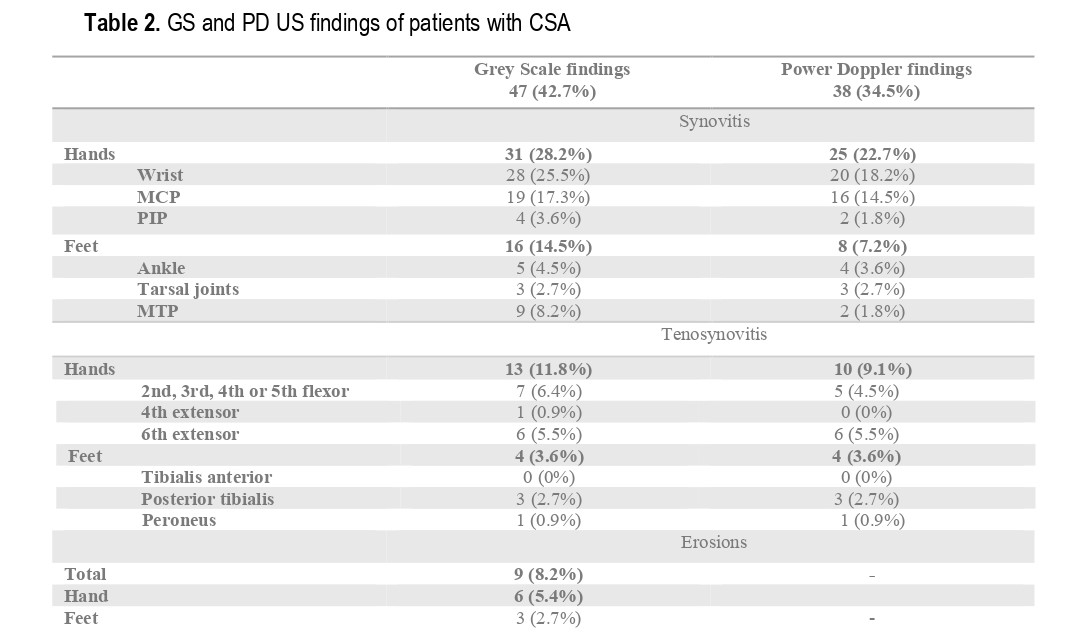Session Information
Date: Monday, November 8, 2021
Session Type: Poster Session C
Session Time: 8:30AM-10:30AM
Background/Purpose: It is of great importance to identify patients with clinically suspect arthralgia (CSA) who will develop rheumatoid arthritis (RA) or other inflammatory arthritis (IA) because an early diagnosis and initiation of DMARD therapy of these patients is associated with better long term outcomes. Thus, a prompt detection of inflammation and identification of predictors factors of RA is desirable. Our objective is to determine the usefulness of power Doppler (PD) ultrasound (US) to predict RA development in patients with CSA.
Methods: Retrospective analysis of a US unit cohort over a one-year period. Patients with CSA and no previous diagnosis of IA were included for analysis. All underwent bilateral US examination of hands and/or feet according to the EULAR guidelines. All US examinations were performed by the same rheumatologist, unaware of the physical exam by the referring rheumatologist. The presence of synovitis and tenosynovitis was assessed on a semiquantitative scale (0-3) for gray scale (GS) and PD, respectively. Active US inflammation was defined as synovitis and/or tenosynovitis with PD signal grade ≥1 at any location. RA diagnosis according to clinician criteria 6 months after the US examination was checked. Univariate and multivariate logistic regression models were employed to investigate possible predictive factors of RA development.
Results: A total of 110 CSA patients (80 females, mean age 53.6 years) were included for analysis., Baseline characteristics of the patients with and without development of RA are shown in Table 1. US active inflammation was present in 38 (34.5%) patients (28.2% showed PD synovitis and 19.1% PD tenosynovitis) (Table 2). After 6 months of follow up, 14 (36.8%) of the patients with US active inflammation at baseline evolved toward RA, while none of the patients without PD findings (p< 0.01) had the same evolution. In those patients who evolved to RA, the presence of GS and PD findings at US examination were significantly higher at baseline versus those who did not (100% vs 35.4%, p >0.001 and 100% vs 25%, p >0.001, respectively). Higher ACPA levels, but not RF, were also found to be associated with RA development (462±693.4 vs 30.2±127.6, p< 0.001). In the multivariate analysis, only ACPA (OR 1.004; 95%CI 1-1.007) and the presence of PD US findings at baseline (OR 13.1; CI 1.07-161.04) were found to be independent predictive factors of an evolution towards RA.
Conclusion: US is able to detect features of subclinical inflammation in CSA patients. Both ACPA and the presence of PD findings at baseline US assessment are independent predictors of RA development in CSA patients.
 *Multivariate analysis: odds ratio with confidence intervals analysis done if P < 0.2 in univariate analysis.
*Multivariate analysis: odds ratio with confidence intervals analysis done if P < 0.2 in univariate analysis.
To cite this abstract in AMA style:
López K, Castrejón I, Nieto J, Rivera J, González T, Montero F, González C, Alvaro-Gracia J, Molina J. Ultrasound in Clinically Suspect Arthralgia: The Role of Power Doppler to Predict Rheumatoid Arthritis Development [abstract]. Arthritis Rheumatol. 2021; 73 (suppl 9). https://acrabstracts.org/abstract/ultrasound-in-clinically-suspect-arthralgia-the-role-of-power-doppler-to-predict-rheumatoid-arthritis-development/. Accessed .« Back to ACR Convergence 2021
ACR Meeting Abstracts - https://acrabstracts.org/abstract/ultrasound-in-clinically-suspect-arthralgia-the-role-of-power-doppler-to-predict-rheumatoid-arthritis-development/

